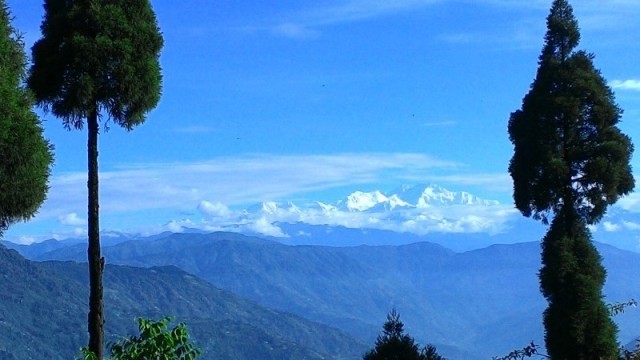
Jorpokhri--where the wind sings among pines
The blue-green hills of eastern Himalaya beckons us ever so often. In our quest to go far from the jaded monotone of city life last month we travelled to Jorpokhri, a pine-wrapped, mist-enveloped mountaintop in Darjeeling district of India's West Bengal state.
At 7,400 feet it is higher than the queen of Hills (6,700 feet).
Jorpokhri is like a table top on the hills, set amidst lush pine and dhupi forest. In fact, it is part of the Senchal forest and is a nature reserve. Its advantageous position offers visitors a sweeping view of the Himalayan snow peaks, including the majestic Mt. Kanchendzonga, on one side and the Darjeeling and Kurseong (locals pronounce it as Kharsing) landscape.
We reached on a Sunday afternoon and checked into the GTA (Gorkhaland Territorial Administration)-maintained Tourist Lodge, the sole hotel there. The rooms have to be booked in advance, which we did in Kolkata (Gorkha Bhawan, Salt Lake, near CC I).
.jpg)
The rooms have large windows facing the mountains. But sleepy, serene Jorpokhri was wrapped in clouds. We were up at the crack of dawn the next day to check the weather. Swirling mist and clouds greeted us. Dejected, I went back to sleep. Before 6 my husband woke me up. He was elated. The snowy Himalaya had revealed itself!
We put on our woolens and rushed down into the manicured garden. What we encountered was enchanting, to say the least. The Himalaya stood some distance away in all its splendour and finery, the azure sky completing the setting perfectly.
On a clear day and from one side of the lake you can gaze at the breathtaking views of the majestic peaks. On the other side, you can see Darjeeling and Kurseong town landscapes. You can spend hours watching the splendours.
The twin lakes make Jorpokhri eponymous. 'Jor' means two and 'pokhri' stands for a lake or water tank.
The boundary of the natural lake has been concretized with seating arrangements so that visitors can enjoy the area. There is a huge model of a snake and a fountain in the middle of the tank. Swans swim about, adding to the charm. Locals told us that the Himalayan Salamander used to dwell in the lake. There is a lovely garden complete with seasonal blooms. Pine trees have been planted on the periphery. Clouds play hide and seek with the sun, often drenching the surrounding.
From one side of the lake a paved pathway leads to a stairway and on top, there is a shaded viewing area. This is the place to get the best views of the mountains, the beautifully landscaped gardens, the lake and the rows of pine trees.

You can have your meals at the tourist lodge. There is also a small shop facing the lake selling momos(dumplings), instant noodles, biscuits, chips and tea, and coffee. Tourists come by carloads, click pictures, grab a bite in the tiny restaurant and leave. Many are surprised by our choice to stay at a place which has 'no entertainment'.
To reach Jorpokhri one has to reach Sukhiapokhri first which is 1.5 km downhill. There is an apology for a road which is also rather steep. We preferred walking this stretch daily to soak in the beauty. The wind blowing through the sturdy pines made magical notes. Bird calls completed the ensemble. There are concrete benches on the wayside for weary travelers to rest.
Midway there is a small graveyard. Mists floating about the tall pines and the 'tip-tap' tip-tap' of water dripping from the trees add another dimension.
.jpg)
I cherish the solitary walks in the winding hills which deliciously offer occasional incursions within.
At night one can see the distant lights of Kurseong and Bagdogra (the nearest and only airport). From our perch on Jorpokhri it was wondrous to see lightening light up the sky there. Soon rushing clouds covered the star-studded sky above us.
Jorpokhri is close to the India-Nepal border. It is 21 kilometers from Darjeeling, 85 kilometers from Siliguri and 5.5 kilometers from Lepchajagat, our next destination. It is located on the road from Ghum to Mirik.
.jpg)
A 30-minute car ride took us to Pashupatinath Market on the Indo-Nepal border. We strolled into the neighbouring country and spent some time in its bazaar and took in the sights and sound. The roads are comparatively cleaner. There is less traffic. We entered a small 'dhaba' for some tea and learnt that the owner hailed from Manipur.
Another day we took a trip to Chitre, a small mountain village bang on the Indo-Nepal border. It is the first place along the way to Sandakphu (the highest point in West Bengal) where trekkers and tourists halt for a while. The road and the trekking trail from Mane Bhanjang up to Chitre is considered one of the steepest in the entire stretch to Sandakphu.
Chitre is located at an altitude of 8,340 ft and about 3 km from Mane Bhanjang. At stretches, the road is so steep that our driver, an affable gentleman named Madan, apologetically asked us to get down. We disembarked and walked up the sheer incline.
.jpg)
Chitre's main attraction is the old Buddhist Monastery and the beauteous surrounding. We were told that had the sky been clear we would have got a marvelous view of the Kanchendzonga.
A calm envelopes the monastery. There is silence everywhere. As we walk in we see a monk arranging butter lamps. Ahead of the main monastery are eight small stupas elevated from the ground.
There are acres and acres of undulating meadows, with trees dotted here and there. The surrounding greenery calms us. Colourful flags are strung across these meadows. There is an asphalt road which cuts through India and Nepal.
Here borders merge seamlessly, your I-card is just a piece of paper and all that matters is oneness with Nature.
At Chitre we come across a group of youngsters who are trekking to Sandakphu.
From Jorpokhri one can go to Darjeeling, Mirik, Lepchajagat and Kurseong even for day trips.
Nearby Sukhiapokhri is the spot for taking the Sandakphu trek. So trekkers can also stay at Jorpokhri before the long haul.
.jpg)
Image:Chitre Monastery
The closest railhead is New Jalpaiguri (NJP). From NJP one can hire a car to Jorpokhri. You can either travel via Mirik that takes 3.5 hours or via Kurseong, which takes more than 4 hours.
Admittedly the Mirik route is more scenic because of its acres of tea gardens. Its said that the tea here is the best.
Support Our Journalism
We cannot do without you.. your contribution supports unbiased journalism
IBNS is not driven by any ism- not wokeism, not racism, not skewed secularism, not hyper right-wing or left liberal ideals, nor by any hardline religious beliefs or hyper nationalism. We want to serve you good old objective news, as they are. We do not judge or preach. We let people decide for themselves. We only try to present factual and well-sourced news.






